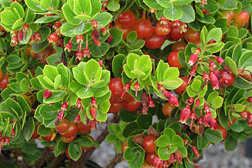This page has been archived and is being provided for reference purposes only. The page is no longer being updated, and therefore, links on the page may be invalid.
|
|
|
|
Scientists Release First Cultivated 'Ōhelo Berry for Hawaii
By Stephanie YaoSeptember 24, 2010
The first cultivar of 'ōhelo berry, a popular native Hawaiian fruit, has been released by U.S. Department of Agriculture (USDA) scientists and their university and industry cooperators.
'Ōhelo (Vaccinium reticulatum Smith) is a small, native Hawaiian shrub in the cranberry family, commonly found at high elevations on the islands of Maui and Hawaii. As people scour the landscape to harvest this delectable berry for use in jam, jelly and pie filling, they unfortunately disrupt the fragile habitats where this plant grows.
In an effort to reduce damage to the environment and meet consumer demands, horticulturist Francis T.P. Zee, with the USDA Agricultural Research Service (ARS) Pacific Basin Agricultural Research Center (PBARC) in Hilo, Hawaii, is evaluating 'ōhelo for small farm production and ornamental use. Zee collaborated with fellow ARS scientists and cooperators at the University of Hawaii at Manoa, Big Island Candies and the Big Island Association of Nurserymen. ARS is the principal intramural scientific research agency of USDA.
Zee and his team selected the offspring of seed-grown plants to create the new cultivar "Kilauea" for berry production. They found 'ōhelo's tiny seeds readily germinated under 20-30 percent shade in well-watered and well-drained potting mixture. Plant hardiness and vigor improved with age, and some seedlings flowered just 10 months after germination, much sooner than the 5 years reported in previous studies. The 16-month-old plants Zee successfully transplanted from the greenhouse to the field produced berries a year later.
Zee also used cuttings and tissue culture to propagate selected 'ōhelo of high ornamental potential. With proper care, young, growing shoots of 'ōhelo can be groomed into vibrant, colorful ornamental potted plants. Since the plant is not seasonal, its readiness for market can be scheduled by trimming and fertilizing. Older potted 'ōhelo plants can be trained into a bonsai and can readily adapt to the office environment.
Zee and PBARC scientists are currently examining the disease and insect problems associated with growing potted 'ōhelo. Full descriptions of Zee's 'ōhelo studies can be found on the University of Hawaii's College of Tropical Agriculture and Human Resources' (CTAHR) website.

